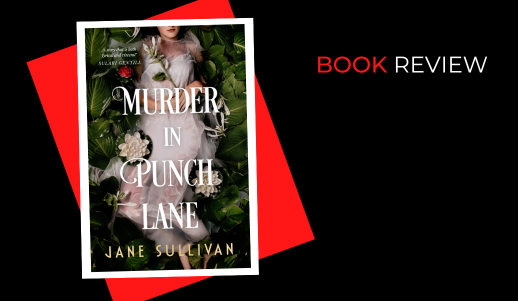by Jane Sullivan
Publisher: Echo Publishing, 2024
Publisher’s blurb
Inspired by real events and people, Murder in Punch Lane is a dark and gripping crime novel that maps the sins and secrets of nineteenth-century Melbourne.
Melbourne, 1868.
When dazzling theatre star Marie St Denis dies in the arms of her best friend, fellow actress Lola Sanchez, everyone believes it was suicide by laudanum overdose. Everyone except Lola. On the brink of stardom herself, she risks everything by embarking on a quest to find Marie’s killer.
When journalist Magnus Scott, writing as ‘the Walking Gentleman’, publishes a compassionate obituary about her friend, Lola decides to seek his help. A fraught attraction develops between these two amateur detectives from opposite sides of society, and their volatile relationship soon begins to compromise their investigation.
Lola keeps a secret from Magnus. She traverses the corrupt underbelly of the brash young metropolis just as he does, but disguised as a boy, entering dangerous, forbidden spaces where the lives of the rich and privileged intersect with the city’s underclass and outsiders: bohemians, theatre folk, prostitutes, down-and-outs and opium addicts.
Neither are prepared for the truths they will uncover about the powers that rule Melbourne – or the consequences for their own lives. And now they must race to find the murderer before the city destroys them both.
Review
by Karin Kos
Murder in Punch Lane is a gripping read that follows Lola Sanchez’s pursuit for justice after the death of her best friend and fellow thespian Marie St Denis, whose demise is shrouded in ambiguous circumstances. Lola quickly ascertains that Marie’s death is by no means a suicide from a sedative overdose as others would have her believe, raising questions from those in polite society that refuse to give answers, especially to a woman.
Set in pre-federation Melbourne in 1868, this novel is crafted by Jane Sullivan to pose whether historical leaders of society – like Sir Redmond Barry and his ilk – were responsible for the demise of vulnerable young women. Through her journalistic approach, Sullivan has researched 1860’s Melbourne thoroughly; depicting streets, suburbs and society in an authentic way that captures her reader’s imagination. The depth of her research allows the reader to walk the streets with Lola and see this world of excess and exploitation through observant eyes.
This highly engaging narrative gives life to the stage of Melbourne theatre and draws the reader to question the real downfall of Marie, through reimagining a dark past that history books would rather forget. The backdrop of the world of theatre and the way that young women were exploited for their beauty and not just their talent is palpable. Here, the theatre director Mr Montgomery takes on a hue of malevolence that is all too realistic and draws into question behaviour that contemporary society would challenge.
Sullivan depicts the fearless Lola through dialogue that as a reader I felt I could connect with. Her boyish ways as she “tried so hard to prove she was as good as any boy”, her determination, and her search for the truth kept me wanting to read more. I was invested in the lyrical portrayal of the actress, Lola. As “her voice softened” it awakened a realisation that for her to have any control or sense of agency, she needed to strategise with the men around her; to never become their next victory, but to set her own adventure on her terms. With her newly found sidekick Marcus Scott, providing an entrance into the realm of men – through his own marred and confused past – his vulnerability to the movers and shakers of a fledgling Melbourne posits him as equally disempowered with those in power. Irrespective of his tragic past, Marcus being the editor of The New Bohemian, epitomises the journalist wanting the truth, only to receive it at his own personal cost. Sullivan allows Lola to define her own terms with Marcus, often leading him along the way of his own emotional battles to find justice for Marie.
Readers are bound to find themselves musing over the cobbled lanes of 1860’s Melbourne, imagining themselves at the theatre in the dress circle watching Lola rehearse her part as Ophelia, and feeling the tension as she breaks into Redmond Barry’s mansion in Carlton. More so, Sullivan casts a landscape of deception and misogyny as a critique of Melbourne’s foundational men. She encourages her readers to question what they know about their beloved city, through multiple red herrings and moments of scandalous behaviour; ensuring that you too will find it difficult to put this book down.
Murder in Punch Lane is worth every moment and certainly does not disappoint.
